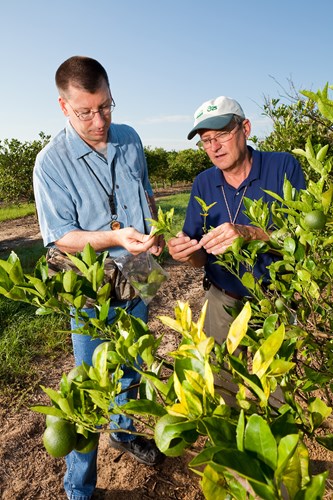Flushing Out Citrus Greening Infection
Huanglongbing (HLB), or citrus greening, has cost Florida citrus growers an estimated $1.3 billion since 2005 and is a major threat to the entire U.S. citrus industry.
“It’s a crisis facing citrus growers everywhere, particularly in Florida, and we are aggressively seeking solutions,” says David G. Hall, an Agricultural Research Service (ARS) entomologist in Fort Pierce, Florida.
|
|
HLB is caused by a bacterium and is spread by the Asian citrus psyllid, which feeds on leaves of infected trees and carries the disease from tree to tree. Insecticides are currently the best option for controlling HLB, and Hall’s research gives growers much-needed guidance on the best times to use them. He has shown that citrus trees are most susceptible to infection—and should be sprayed with insecticides—when they are producing new leaves, a cyclical phase known as “flush” that happens three or four times a year.
The flush cycle in Florida citrus usually begins in February, in late May, and again in late August. It typically lasts between 25 to 30 days. Researchers can prompt new leaf development at almost any time of year by trimming small branches.
Hall has spent years inoculating citrus trees with HLB to evaluate resistance, and those efforts led him to wonder about the effects of flush on HLB infection rates. To compare infection rates at different stages of flush, Hall and his colleagues trimmed the branches of groups of trees at three staggered intervals.
The first group was trimmed 3 weeks before the trees were exposed to infected psyllids. This simulated the “old flush” stage. A second group (“new flush”) was trimmed 1 week before psyllid exposure, and a third group (“no flush”) was trimmed just before the psyllids were released.
Immediately after the third trimming, the researchers released 20 HLB-infected psyllids per tree and let them feed for a week.
They used Valencia orange trees and US-942 citrus trees, a popular hybrid, and evaluated them for infection rates after 6 months.
The results indicated that the trees in flush had much higher infection rates than the no-flush trees and that the old-flush group had the highest infection rates. The differences were pronounced in both types of trees. For example, in one trial, 80 percent of Valencia trees with older flush became infected; 23 percent with new flush became infected; and only 3 percent of trees with no flush became infected.
The findings show growers the importance of monitoring for psyllids when their trees are in flush. “It’s a critical stage in the tree’s life cycle, and it’s the trees with older flush that growers really need to worry about,” Hall says.
Future research may be able to determine why old-flush trees had higher infection rates, Hall says.—By Dennis O'Brien, ARS Office of Communications.
“Flushing Out Citrus Greening Infection” was published in the August 2016 issue of AgResearch Magazine.
Key Facts
- HLB is a citrus disease that has cost Florida growers $1.3 billion since 2005.
- Citrus trees are most vulnerable to HLB when new leaves are growing.
- ARS scientists found the best time to treat trees is during new leaf growth.
Full Story








